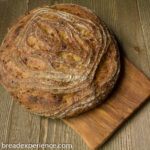Description
This Sourdough Cottage Cheese Dill Bread with Onions and Spelt is not your average cottage cheese loaf. This one is made with sourdough instead of yeast or baking powder, utilizes a cold fermentation in the refrigerator overnight, and can be baked as a hearth loaf or in a loaf pan.
Ingredients
Units
Scale
- 300g All-Purpose Spelt Flour
- 100g Whole Grain Spelt Flour
- 100g Sourdough Starter (I used a whole grain spelt starter but any starter will work)
- 500g Cottage Cheese, small curd, 4% milk, COLD.
- 25 – 50g Water, room temp
- 8g Salt, (a lot of Cottage Cheese has salt added in so you may want to add less)
- 30g Cooked Onions, Finely Diced Saute/Caramelized Onions
- 1 1/2 tsp. Chopped Dill, dried (can use fresh as well about 12 g)
Instructions
- Place the sourdough starter in a large bowl, add the water and stir to break up the starter. Stir in the Cottage Cheese and Onions and mix well.
- Combine the Flour, Salt, and Dill and add to the wet ingredients. Mix using a Danish dough whisk or wooden spoon until combined.
- Cover bowl with a kitchen towel and let the dough rest for 30 minutes. Fold the dough in the bowl. It will be very sticky at this point.
- Cover the bowl and let the dough bulk ferment for 3 hours. After 1 hour, fold the dough on a lightly floured counter, then place it back in the bowl. Let it rest for another hour, then repeat the fold. Place it back in the bowl and let it rest for the final (3rd) hour. The dough should be more workable at this point, but will probably still be a bit sticky.
- Cover the bowl tightly with plastic wrap and place it in the refrigerator overnight.
- The next day, remove the dough from the fridge and shape it (cold) into a tight round boule. Place the boule seamside up in a heavily dusted banneton proofing basket if baking a hearth loaf or in a greased or parchment-lined loaf pan if baking a regular loaf.
- Proof the loaf in the banneton basket or loaf pan at room temperature for 2-3 hours, depending on the temperature in your kitchen.
- At least 45 minutes prior to baking, preheat the oven to 475*F with a Dutch oven, or other bread baker on the bottom shelf. I used a ceramic bread baking cloche to bake this loaf.
- After the oven and bread baker are preheated sufficiently, carefully remove the baker from the oven (using heavy-duty oven mitts), and place the lid and base on thick towels or potholders to protect them from breaking due to the extreme temperature change. Be careful not to place them directly on a cold countertop.
- Sprinkle the base of the baker with cornmeal and carefully flip the loaf from the proofing basket onto the cornmeal-dusted base. Score the loaf in the pattern of your choice. Carefully place the base (with the loaf on it) in the oven and cover with the cloche lid.
- Bake for 25 – 30 minutes with the lid on. Remove the lid and place it on a towel. Lower the oven temp to 450*F and continue to bake the loaf with the lid off for an additional 15 minutes or until done. The loaf should be a dark golden brown and sound hollow when thumped on the bottom.
- Carefully remove the loaf and base from the oven. Let the loaf cool completely on a wire rack before slicing or serving.
Notes
Adapted from Cottage, Cheese, Dill, and Onion Bread by Michael Sawinski
- Category: Sourdough
